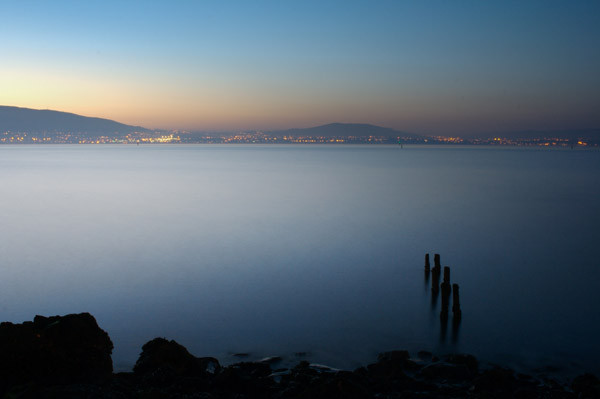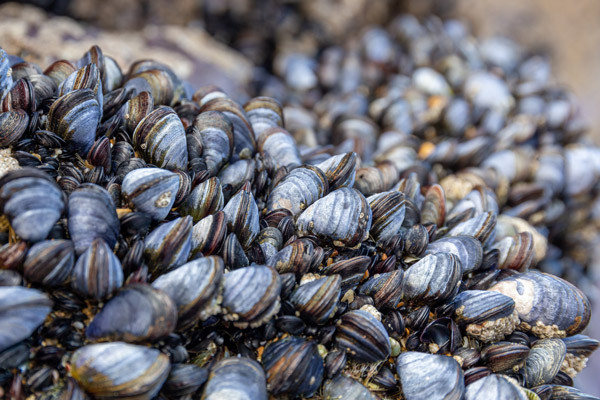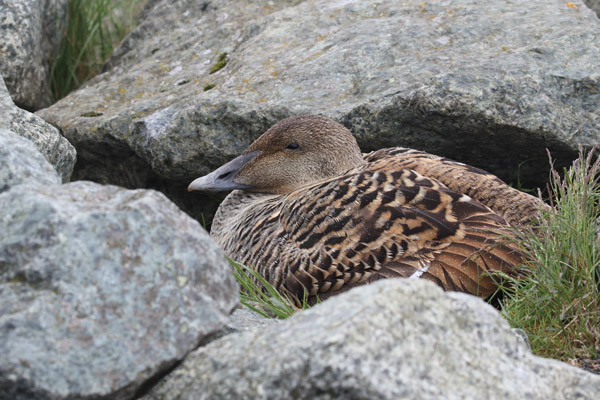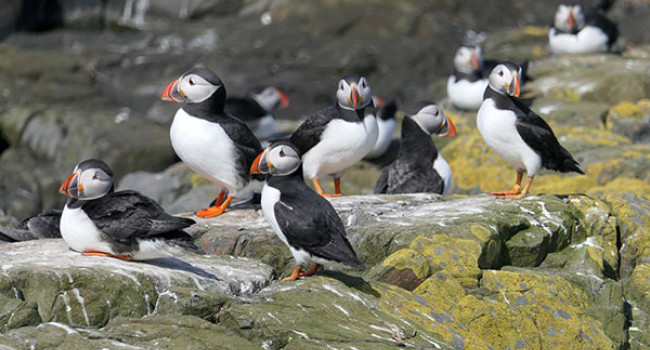
Belfast’s Unsung Seabird
Belfast Lough may be nestled between gentle hills to the north and south, but its sheltered, shallow waters are far from tranquil. This cold slice of the Irish Sea funnels directly into Northern Ireland’s iconic capital and hums with activity 24/7. Its surface is crisscrossed with ferries, cargo ships, fishing vessels and pleasure craft and its shores are alive with walkers, dogs and birdwatchers. It really is all go–go–go.
Belfast’s gateway to the island of Ireland has been used heavily by people for centuries. Despite this, bird life thrives here with a buzz and clamour to match its human neighbours in the big city. Indeed, Belfast Lough’s Special Protection Areas (SPAs) are some of Northern Ireland’s most important wetland sites. Slender Black-tailed Godwits jab frantically at invertebrates in the mudflats, gangs of Black-headed Gulls laugh and squabble over shoreline scraps and dagger-faced Great Crested Grebes patrol the lough’s surface, a flick of their large feet sending them into the depths to hunt.
Among these favourites, crowds of a particularly striking waterbird take advantage of the lough’s shallow waters during the winter. At their peak, thousands of Eiders may gather – males in strict formal wear, black and white with the faint flush of a winter sunrise on their breast, stylishly offset with a subtle sage nape, and females in their cryptic speckled cinnamon.
Eiders are well known for their treasured, insulating ‘eiderdown’, but they hold several other notable distinctions among ducks of the British Isles: they are our heaviest at a chunky 2.2 kg, and despite their bulk are one of the fastest birds in level flight, clocking in at an impressive 47.2 mph. Unusually for a duck, they are fully marine all year round, and due to this Eiders are considered an unsung seabird by many.

The Eider in Ireland
Due to the impacts of hunting, shellfish harvesting, pollution and disturbance, Eiders are Near Threatened globally, and consequently, they are Red-listed on the island of Ireland. However, the eastern coastlines of Counties Antrim and Down, soon to be part of a new Marine SPA encompassing six important existing SPAs, host a staggering 77% of the total Irish wintering population of Eider. Within this area, Belfast Lough is lucky enough to represent the largest gathering of Eider in Ireland, putting it at the heart of conservation for this charismatic seaduck.
For waterbirds like Eiders, Belfast Lough is full of opportunity, but it’s a high stakes game. Throughout the desperately short, dark days, the lough’s bird life hustles for its next meal to survive to the spring. Increased vigilance – watching for threats – and displacement both interrupt important foraging behaviour, reducing the time available for feeding, so any disturbances have the potential to negatively impact survival during this critical period.
Listen to the Eider's cooing song
Many seabird studies focus on the breeding season, and less is known about populations of wintering seaducks even though our coastal areas provide them with vital habitat. To further its mission to support future Marine Protected Area management in Northern Ireland, the Republic of Ireland and Western Scotland, the Marine Protected Areas Management and Monitoring (MarPAMM) Project contracted the BTO to learn more about Belfast’s important wintering Eider population.
The project had three key strands: improving current knowledge of Eider numbers and distribution in Belfast Lough, investigating their movements through daylight and tidal cycles, and identifying potential sources of disturbance that might impact the population’s health.
Eiders were a rarity in the lough as recently as the early 20th century, but around 3,500 Eiders now winter there annually.
Diving into the data

The first step in our investigation was to delve into the Wetland Bird Survey (WeBS) counts to assess abundance trends of Eider in the lough. Through the efforts of dedicated BTO volunteers and support from the Northern Ireland Environment Agency, Belfast Lough enjoys excellent WeBS coverage both during high tide and low tide counts, giving us plenty of data to work with. We found that, although Eiders were a rarity in the lough as recently as the early 20th century, around 3,500 Eiders now use the lough annually, and this number has risen faster than the overall Northern Irish population. The contrast to the regional trend suggests the recent boost in Eider numbers in Belfast Lough is driven by locally favourable conditions, particularly along the north shore, rather than a result of regional-level growth in the Eider population.
WeBS data are a fantastic resource to look for trends and totals, but a finer-scale assessment of Eider on the lough required some hardy surveillance. Despite the Eider’s large size and flashy good looks, they can be surprisingly difficult to count; the shoreline of Belfast Lough does not offer many vantage points over the water, and visibility is affected by glare, choppy waves, wind and fog, all common features of the lough in the winter!
Sub-contracted surveyors Kerry Leonard and Dave Allen braved the winter chill to record Eiders at four locations along the north shore throughout the tidal cycle between November and March. Counts made at regular intervals throughout the tidal cycle revealed that Eiders were greatest in number early in winter, peaking in November and tailing off towards spring. By March, Eiders were beginning to disperse towards their breeding grounds and were less concentrated in the lough.

Tussles for mussels?
Eiders are fiercely strong divers, powering themselves deep into the water by alternating beats of their half-open wings with strokes of their paddle-like feet, and can reach depths of up to 42 m to forage on the seabed. However, the energetic costs of diving are large, and it is likely that Eiders target low tides to minimise the effort required to wrest their prey from the bottom of the lough. This was reflected in the data we collected, which showed that low tides were a good predictor of high Eider numbers along the north shore.
Eiders consume a wide range of marine invertebrates but are particularly partial to mussels. Previous research suggests that cultivated mussels are a more profitable prey source for seaducks than intertidal mussels because they have relatively thinner shells. As Eiders eat the mussels whole, shells and all, a less robust shell probably makes these seafood delicacies easier to digest.
Although our study did not include an analysis of Eiders’ diet, it may be that the birds are drawn to the shallow waters of Belfast Lough for easy access to the mussels that are farmed along the north shore. Shellfish aquaculture is an economically important feature of Northern Ireland’s sea loughs and the revival of the aquaculture industry in Belfast Lough could well have created an excellent foraging opportunity for Eiders in recent years.

Working for the Eider’s future
Our study did not find much evidence that Eiders were affected by human disturbance in Belfast Lough, which most commonly came from boat traffic. However, we only investigated the probability of Eiders fleeing from disturbances; there is still more to be learned about how disturbance may impact foraging behaviours. For example, disturbance threat could increase vigilance or ‘look-out’ behaviour, which reduces the time that these birds can spend feeding.
Although we found that Eiders rarely moved in response to marine traffic, our surveys did suggest that there may be some tension between boat-users and waterbirds in the lough, with some boats seen to deliberately pursue flocks of Eiders, disrupting thousands of birds. Female Eiders lose a significant amount of body mass during their long incubation period in spring, so they must boost their body condition in preparation for this by feeding well over winter. Therefore, disturbances that result in reduced foraging time and increased energy expenditure during the critical winter period have the potential to increase Eider mortality in the breeding season, and may reduce the number of chicks that are raised successfully.
The contrasting requirements of human activities and the growing Eider population may create conflict between economic interests and conservation objectives in Belfast Lough. Our report to the MarPAMM project recommends bringing together organisations and individuals with interests in the many values of Belfast Lough, from recreation and industry to conservation, to collaboratively seek a better understanding of the emerging issues and to develop mitigation measures for the benefit of all – not least, the unsung seabird of Belfast.
Acknowledgements
This work is part of the Marine Protected Areas Management and Monitoring Project (MarPAMM) project. This project has been supported by the EU’s INTERREG VA Programme, managed by the Special EU Programmes Body. Match funding has been provided by the Department of Agriculture, Environment and Rural Affairs (NI) and the Department of Housing, Local Government and Heritage (IRL).
Belfast Lough waterbird abundance data were provided by WeBS, a Partnership jointly funded by the British Trust for Ornithology, Royal Society for the Protection of Birds and Joint Nature Conservation Committee, in association with The Wildfowl & Wetlands Trust, with fieldwork conducted by volunteers. Although WeBS data are presented within this report, in some cases the figures may not have been fully checked and validated. Therefore, for any detailed analyses of WeBS data, enquiries should be directed to the WeBS team at the British Trust for Ornithology, The Nunnery, Thetford, IP24 2PU (webs [at] bto.org).







Share this page